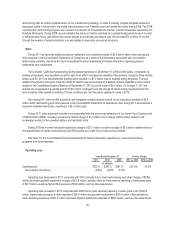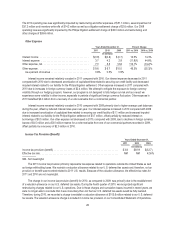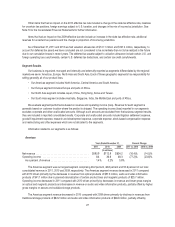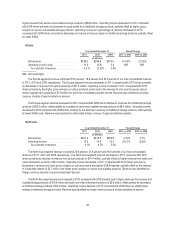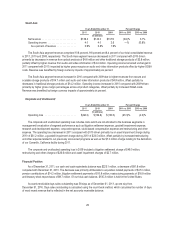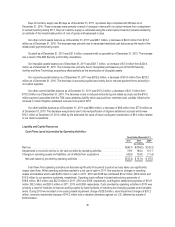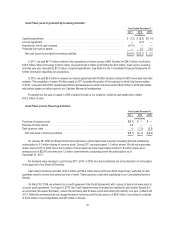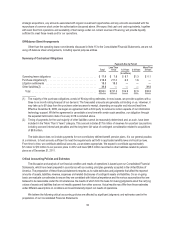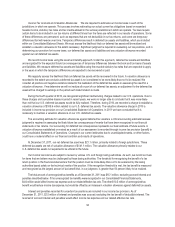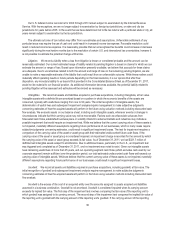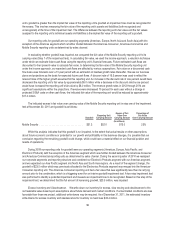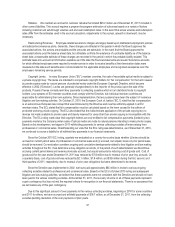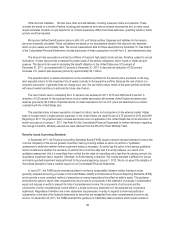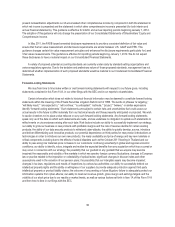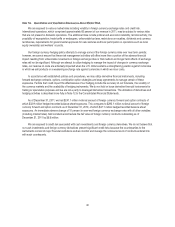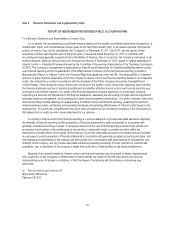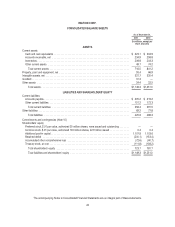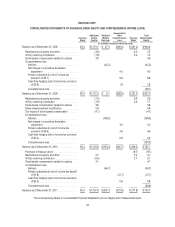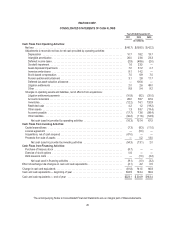Memorex 2011 Annual Report Download - page 38
Download and view the complete annual report
Please find page 38 of the 2011 Memorex annual report below. You can navigate through the pages in the report by either clicking on the pages listed below, or by using the keyword search tool below to find specific information within the annual report.Our U.S. federal income tax returns for 2004 through 2010 remain subject to examination by the Internal Revenue
Service. With few exceptions, we are no longer subject to examination by foreign tax jurisdictions, or state and city tax
jurisdictions for years before 2005. In the event that we have determined not to file tax returns with a particular state or city, all
years remain subject to examination by the tax jurisdiction.
The ultimate outcome of tax matters may differ from our estimates and assumptions. Unfavorable settlement of any
particular issue may require the use of cash and could result in increased income tax expense. Favorable resolution could
result in reduced income tax expense. It is reasonably possible that our unrecognized tax benefits could increase or decrease
significantly during the next twelve months due to the resolution of certain U.S. and international tax uncertainties; however it
is not possible to estimate the potential change at this time.
Litigation. We record a liability when a loss from litigation is known or considered probable and the amount can be
reasonably estimated. Our current estimated range of liability related to pending litigation is based on claims for which we can
estimate the amount or range of loss. Based upon information presently available, we believe that accruals for these claims
are adequate. Due to uncertainties related to both the amount and range of loss on the remaining pending litigation, we are
unable to make a reasonable estimate of the liability that could result from an unfavorable outcome. While these matters could
materially affect operating results in future periods depending on the final resolution, it is our opinion that after final
disposition, any monetary liability to us beyond that provided in the Consolidated Balance Sheet as of December 31, 2011,
would not be material to our financial position. As additional information becomes available, the potential liability related to
pending litigation will be assessed and estimates will be revised as necessary.
Intangibles. We record all assets and liabilities acquired in purchase acquisitions, including intangibles, at fair value.
Intangible assets with a definite life are amortized based on a pattern in which the economic benefits of the assets are
consumed, typically with useful lives ranging from one to 30 years. The initial recognition of intangible assets, the
determination of useful lives and subsequent impairment analysis require management to make subjective judgments
concerning estimates of how the acquired assets will perform in the future using valuation methods including discounted cash
flow analysis. We evaluate assets on our balance sheet, including such intangible assets, whenever events or changes in
circumstances indicate that their carrying value may not be recoverable. Factors such as unfavorable variances from
forecasted cash flows, established business plans or volatility inherent to external markets and industries may indicate a
possible impairment that would require an impairment test. While we believe that the current carrying value of these assets is
not impaired, materially different assumptions regarding future performance of our businesses, which in many cases require
subjective judgments concerning estimates, could result in significant impairment losses. The test for impairment requires a
comparison of the carrying value of the asset or asset group with their estimated undiscounted future cash flows. If the
carrying value of the asset or asset group is considered impaired, an impairment charge is recorded for the amount by which
the carrying value of the asset or asset group exceeds its fair value. As of December 31, 2011, we had $321.7 million of
definite-lived intangible assets subject to amortization. Due to additional losses, particularly in the U.S., an impairment test
was triggered and completed as of December 31, 2011, and no impairment was noted to exist. Given our intangible assets
have remaining useful lives of more than 25 years, and our operating segment cash flows (which excludes cash used by our
corporate segment) remain sufficient over the projection period, our total estimated undiscounted cash flows well exceed our
carrying value of intangible assets. While we believe that the current carrying value of these assets is not impaired, materially
different assumptions regarding future performance of our businesses could result in significant impairment losses.
Goodwill. We record all assets and liabilities acquired in purchase acquisitions, including goodwill, at fair value. The
initial recognition of goodwill and subsequent impairment analysis require management to make subjective judgments
concerning estimates of how the acquired assets will perform in the future using valuation methods including discounted cash
flow analysis.
Goodwill is the excess of the cost of an acquired entity over the amounts assigned to assets acquired and liabilities
assumed in a business combination. Goodwill is not amortized. Goodwill is considered impaired when its carrying amount
exceeds its implied fair value. The first step of the impairment test involves comparing the fair value of the reporting unit to
which goodwill was assigned to its carrying amount. The second step of the impairment test compares the implied fair value of
the reporting unit’s goodwill with the carrying amount of the reporting unit’s goodwill. If the carrying amount of the reporting
35


